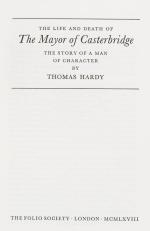Hardy, The Life and Death of The Mayor of Casterbridge: The Story of a man of Ch
The Life and Death of The Mayor of Casterbridge: The Story of a man of Character. Wood Engravings by Peter Reddick.
London, The Folio Society, 1990. 15 cm x 23 cm. 335 pages. Original, illustrated hardcover with gilt lettering on spine. Excellent condition with only very minor signs of external wear. Clean inside with solid binding.
“The Mayor of Casterbridge (1886), subtitled “The Life and Death of a Man of Character”, is a novel by British author Thomas Hardy. It is set in the fictional town of Casterbridge (based on the town of Dorchester in Dorset). The book is one of Hardy’s Wessex novels, all set in a fictional rural England.
Hardy began writing the book in 1884 and wrote the last page on 17 April 1885. Within the book, he writes that the events took place “before the nineteenth century had reached one-third of its span”. Literary critic Dale Kramer sees it as being set somewhat later—in the late 1840s, corresponding to Hardy’s youth in Dorchester.” (Wikipedia)
″Thomas Hardy was born in a cottage in Higher Bockhampton, near Dorchester, on 2 June 1840. He was educated locally and at sixteen was articled to a Dorchester architect, John Hicks. In 1862 he moved to London and found employment with another architect, Arthur Blomfield. He now began to write poetry and published an essay. By 1867 he had returned to Dorset to work as Hicks’s assistant and began his first (unpublished) novel, The Poor Man and the Lady.
On an architectural visit to St Juliot in Cornwall in 1870 he met his first wife, Emma Gifford. Before their marriage in 1874 he had published four novels and was earning his living as a writer. More novels followed and in 1878 the Hardys moved from Dorset to the London literary scene. But in 1885, after building his house at Max Gate near Dorchester, Hardy again returned to Dorset. He then produced most of his major novels: The Mayor of Casterbridge (1886), The Woodlanders (1887), Tess of the D’Urbervilles (1891), The Pursuit of the Well-Beloved (1892) and Jude the Obscure (1895). Amidst the controversy caused by Jude the Obscure, he turned to the poetry he had been writing all his life. In the next thirty years he published over nine hundred poems and his epic drama in verse, The Dynasts.
After a long and bitter estrangement, Emma Hardy died at Max Gate in 1912. Paradoxically, the event triggered some of Hardy’s finest love poetry. In 1914, however, he married Florence Dugdale, a close friend for several years. In 1910 he had been awarded the Order of Merit and was recognized, even revered, as the major literary figure of the time. He died on 11 January 1928. His ashes were buried in Westminster Abbey and his heart at Stinsford in Dorset.” (Amazon)
- Keywords: English Literature · Novel · Novelist
- Language: English
- Inventory Number: 43998AB
EUR 68,--
© 2025 Inanna Rare Books Ltd. | Powered by HESCOM-Software













